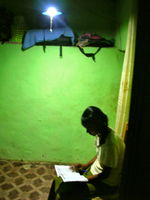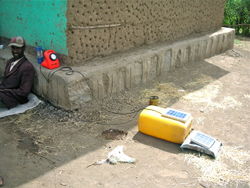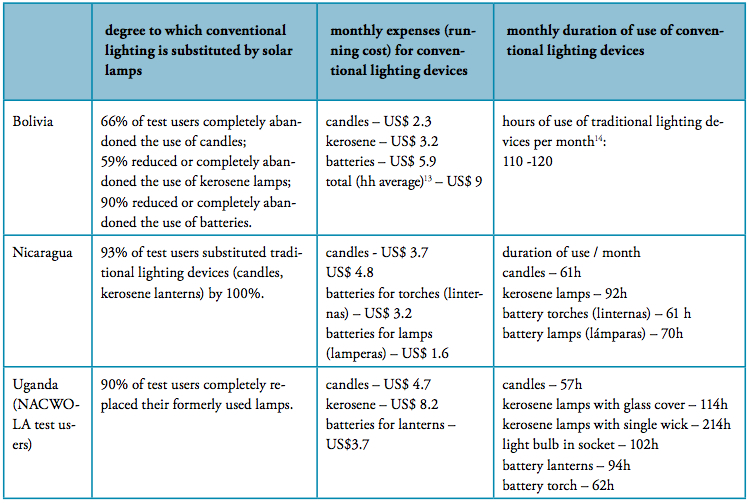Knowledge fuels change - Support energypedia!
For over 10 years, energypedia has been connecting energy experts around the world — helping them share knowledge, learn from each other, and accelerate the global energy transition.
Today, we ask for your support to keep this platform free and accessible to all.
Even a small contribution makes a big difference! If just 10–20% of our 60,000+ monthly visitors donated the equivalent of a cup of coffee — €5 — Energypedia would be fully funded for a whole year.
Is the knowledge you’ve gained through Energypedia this year worth €5 or more?
Your donation keeps the platform running, helps us create new knowledge products, and contributes directly to achieving SDG 7.
Thank you for your support, your donation, big or small, truly matters!
PicoPV Field Tests of GTZ EnDev
Overview
The GIZ PicoPV country survey results underpin that an ‘all-size-fits-one’ lamp model does not exist. The lamp models were rated differently by users across different continents, and they were liked and disliked for different reasons. However, there are some aspects that turned out to be important for consumers in all the test countries.
Above all, light quality, including the size of the light cone and light intensity, mattered most to the majority of respondents. Apart from that, in Latin America it was the radio function that made people like certain lanterns, whereas for African consumers the phone charging function was considered more important. Another selling point for lamps in Uganda was visual resemblance of the kerosene lanterns that are conventionally used there. For these reasons, people felt that the solar lamp could directly replace the traditional model and therefore perceived it as particularly useful and relevant.
Another result that emerged from the research was that consumers are highly suspicious of poor quality products that have only a short lifetime. Even among poor households there is a willingness to pay for quality, and there is evidence that the target consumer groups do think ahead and are not interested in products that may be relatively cheap but have to be replaced after a short time. There is also concern among all potential retailers that maintenance and repair services may be a major hurdle towards the development of PicoPV markets in rural areas, where there is no local expertise on these new kinds of products.
The field survey also revealed certain reservations by different consumer groups against some visual design features that will have to be taken into account for any successful PicoPV marketing strategy. For example, people had very particular positive or negative associations with certain colors or forms which might have an impact on their purchasing decision even though they said that these product features were not decisive factors. One lantern, for example, reminded Ugandan women of a camera, which limited its attractiveness, while in Nicaragua people particularly liked the handy format of the lamp.
In Mozambique, one of the lamp models was described as “masculine” so that women would hesitate to use it. In Uganda, white is associated with religious ceremonies like funerals and therefore not regarded an appropriate color for a lamp.[1]
In Ethiopia, a large angle of radiation was preferred over a high number of lumens. Portable lamps were favored. Users preferred a built-in switch instead of a pull switch. Furthermore, bright, white light was clearly chosen over yellow colored light. Regulators in order to adjust the level of brightness are an additional feature people liked. Importance of mentioned characteristics, such as light quality and good quality of the system itself can be confirmed. Moreover, duration of light and robustness played an important role in the decision to buy a PicoPV system.[2]
How do the lamps perform in everyday field use?
More than 100 firms are offering PicoPV products in developing countries today, but most products are of very low quality, with serious implications for consumer trust in the new technology. Early lab tests have focused the awareness of governments and donors on the importance of quality control and customer information – however, field tests in sufficient countries with sufficient sample sizes are needed for a better understanding of PicoPV performance under real-life conditions, and to identify gaps in the emerging draft lab test procedures. Field tests show, that lab testing does need to be complemented through long-term testing under real-life conditions.
Occurence rate of technical problems (10% to 50%) during a field test in Uganda confirm this statement. Furthermore, the Uganda data highlight the urgent need to introduce quality labeling mechanisms, based on proven test procedures, on international as well as local levels: Almost all lamp models, including top-end products with high quality claims by manufacturers, did not meet expectations in terms of durability and robustness – in spite of the fact that they had been picked as “best of class” in the previous lab test (which in turn was based on the lab test draft methodology currently in use by GIZ as well as World Bank’s Lighting Africa). Particular technical improvements concluded from the Ugandan field tests are: manufacturers need to improve products’ solar fraction, equip lamps only with advanced charge controllers, and work on the robustness of the products, and of the connection parts in particular. Problems were: frequent deep-discharge of batteries, low battery life-spans and overall unsatisfactory lighting service were the frequently observed. Apart from that, the components that most often caused lamps to fail were cables, plugs, input jacks and switches. These parts are obviously under extreme stress when lamps are in everyday use by extended families with several children, and when modules are put down for charging on the ground in the courtyard (while lamps are kept inside to protect them against thieves). [3]
In Ethiopia, broken switches and deeply discharged batteries were a frequent problem. Robustness has to be improved as well, because users often carry their systems around due to fear of theft.[2]
What are the socio-economic benefits users experience?
As part of the baseline analysis of the GIZ field surveys, households were asked to specify their monthly expenditures for conventional lighting devices, whereas the ex-pot survey assessed to which degree the PicoPV lamps had replaced the use of these traditional lighting devices. The finding across countries was that PicoPV lamps have a true potential to substitute conventional lighting sources to a large degree. The associated substantial savings (and poverty alleviation) potential through the use of PicoPV lamps is underpinned by both the GIZ field survey data on lighting costs and the respective Lighting Africa Market Research results from the large-scale household survey in part II of the research project (n=1000 for each country).
Besides the studies mentioned above, market research on Pico PV systems is limited and has so far focused on lighting appliances such as solar lanterns. As rural customers expect more than only light but also other energy services as mobile phone charging or radio, existing studies could be seen as somewhat one-sided.
Kenya (ITC)
In a study conducted by ITC in Kenya in 1998 people in urban and rural areas were asked for what purpose they would use solar lanterns: The main priority was given to (1) ambient lighting in households. This was followed by the desire for (2) studying and reading, using the light to (3) conducting housework during the dark hours and improving the (4) perceived security by having bright light in or in front of their houses. The least importance was given to (5) business. If only rural areas had been taken into account security would have had the lowest ranking (ITC, 1998).
The ITC survey was the first step to discover what customers would expect from their solar lantern. Out of these findings the “Glowstar”-lantern was developed.
India (Stanford University)
A survey (Stanford University 2003) which summarises experience from various states of India indicates that the rural population uses kerosene to a large extent for lighting of approximately 2-4 hours per day. Given that 60% of India’s population live in rural areas, there is a vast market potential for PicoPV, which can cut household energy expenses by replacing fuel-based lighting. The survey also found indication of demand for PicoPV among those parts of the Indian population which have access to the grid, as power supply in most rural areas is highly unreliable. PicoPV may serve as a back-up during power outages for this consumer group which is marked by higher income levels and has a demand for higher quality energy services.
The survey also brought to light that most target customers would not be willing to pay 100% up front in cash for purchasing a system. However, these results vary extremely between various regions. Some of the interviewed groups would prefer some form of microfinance option through retailer financing, village cooperatives or saving groups.
Tanzania (GIZ)
From GIZ experiences in Tanzania, it has been observed that customers prefer to have a switch installed in the house rather than a portable system. Even if it provides only very basic services, there was a preference for small solar home systems at least if they are affordable. Furthermore, a disadvantage of portable systems has been that they can be stolen easily in comparison to a fixed system in the house. A crucial point has also been the recharging of solar lanterns. As they are usually placed outside and oriented to the sun in the morning and remain in the same position throughout the day, the full charging potential cannot be achieved.
Ethiopia (GIZ)

How much are users willing and able to pay?
The willingness to pay for PicoPV products in general, and for certain lamp models in particular, differed enormously between the countries. African users indicated a higher willingness to pay than users in Bolivia and Nicaragua (again, leaving much room for future validation of applied methods and ways to account for potential behavioural differences between survey countries). The figures obtained through Dutch auctions indicate a WTP of 50-90 USD for lamps of the highest value class from a consumers’ perspective. Lanterns falling into a medium value category were bought at 25- 50 USD. The remaining lanterns were sold for 5-25 USD. In spite of these high willingness to pay indications, a central finding from all the country surveys was that many households at the bottom of the income pyramid, which are in fact the main target population for PicoPV lamps, often lack the required cash availability. Even though the purchase of a lamp would pay off within a few months due to savings on running costs of conventional lighting solutions, consumers, notably in rural areas, mostly do not have the cash available to pay the upfront investment and have no access to financial services which could support by-passing this problem. This is a major a hurdle for the large-scale distribution of PicoPV lamps in least developed countries. This is particularly true for the more expensive PicoPV lamp models, which range between 80 and 150 US$ per piece.
A consumer credit scheme piloted in Uganda indicates that the willingness to pay (WTP) for solar lamps among the targeted bottom-of–the-pyramid consumers in Northern Uganda remains below 2010 retail price levels for the tested lamps.
However, it is significantly higher than estimated by previous publications on PicoPV in SSA (e.g. a 2010 Lighting Africa Study finds that users were willing to pay only between 6 and 11 US$ for an ambient light before they used it[4]).
This is in particular the case for the top-end products in the sample: 200.000 USH or 87 USD seems to mark a threshold of WTP for a solar lamp among rural households in the survey area. PicoPV Products beyond this threshold will most probably be difficult to sell at large scale in Northern Uganda. However, a niche market for the high-quality products can be found among the higher income strata in the area, including electrified households that are interested to buy the lamps as back-up lighting devices for the frequent power outages.
Further, the field test observations confirm that information asymmetries between consumers and manufacturers (or dealers) with regard to product durability and robustness strongly distort WTP formation!
As consumer warranties and quality labeling of products are highly under-developed in rural areas in Uganda, people are very hesitant to invest major sums in costly high-quality electric equipment (certainly also because limited household budgets do not allow for such risks).
Table shows how much people spend monthly for traditional lighting devices and how much they are therefore able to pay. Furthermore, degree of substitution of conventional lighting is presented.[1]
References
- ↑ 1.0 1.1 GTZ. 2010. What difference can a PicoPV system make? Early findings on small Photovoltaic systems - an emerging low- cost energy technology for developing countries: GIZ PicoPV Booklet Cite error: Invalid
<ref>tag; name "GTZ10" defined multiple times with different content - ↑ 2.0 2.1 2.2 _ Cite error: Invalid
<ref>tag; name "GTZ11" defined multiple times with different content - ↑ GTZ, iidevelopment. 2010. GTZ Solar Lamps Field Test Uganda - Final Report.
- ↑ Lighting Africa.2010. Solar Lighting for the Base of the Pyramid - Overview of an Emerging Market.





















